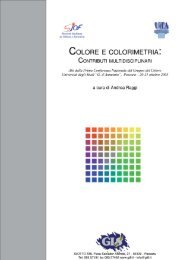Scarica gli atti - Gruppo del Colore
Scarica gli atti - Gruppo del Colore
Scarica gli atti - Gruppo del Colore
You also want an ePaper? Increase the reach of your titles
YUMPU automatically turns print PDFs into web optimized ePapers that Google loves.
with<br />
(10) RS = [ r1 | … | rP ] and AS = [ a1 | … | aP ] .<br />
The (pseudo-)inverse D¯ of matrix D can then be computed by inverting Equation<br />
9 with some chosen technique, and the reflectance r for a generic acquisition<br />
output a can thus be computed using the relationship<br />
(11) r = D¯a .<br />
The mo<strong>del</strong> built, represented by matrix D¯ , is dependent on the illumination, so in<br />
general a new mo<strong>del</strong> will be needed everytime the illumination conditions change.<br />
Also, the acquisition output values ai must be properly corrected to discount the<br />
geometry of the illumination before they can be used to compute the corresponding<br />
reflectance r. In fact, achieving a uniform illumination on the whole scene to be<br />
acquired is usually very difficult; different parts of the scene will typically receive<br />
different amounts of light energy, so that the illuminant function E will actually<br />
vary depending on the point being considered within the scene. This would in turn<br />
make matrix D¯ and the resulting empirical mo<strong>del</strong> dependent on the position<br />
within the scene, so that a different mo<strong>del</strong> would have to be computed for each<br />
point in the scene, which is not feasible. However, it is possible to correct the<br />
acquisition output values to make them independent from the position in the scene;<br />
such correction is usually performed by acquiring a reference physical sample as in<br />
the narrow-band approach, although the result has in this case a different meaning<br />
[2]. The corrected output values can then be used in Equations 8-11 to compute a<br />
single mo<strong>del</strong> which is valid for the whole scene.<br />
Another obvious issue is the choice of the ‘training set’, which is, the set of the<br />
colors used to build the empirical mo<strong>del</strong>. As stated above, this set must be<br />
‘sufficiently representative’ of the whole range of possible colors, which<br />
intuitively means that the resulting mo<strong>del</strong> can actually be extended to any other<br />
color. This is not a clear-cut notion, but specific targets that include a varied<br />
selection of sample colors, such as the Macbeth ColorChecker and ColorChecker<br />
DC [13], are available. Also, some studies that outline the theoretical bases of this<br />
subject and propose working methods to select sample colors were published in<br />
recent years [14,15].<br />
4. A 'wide-band' multispectral acquisition system<br />
The typical wide-band acquisition system uses optical filters coupled with a<br />
monochrome digital camera to simulate sensors of different sensitivity. The same<br />
camera sensors are typically used for all bands, and their sensitivity is modified<br />
each time by putting different optical filters before them. One acquisition is then<br />
performed for each filter to retrieve the acquisition output vectors ai. The optical<br />
filters are the heart of the system; currently, either traditional filters like those used<br />
29





